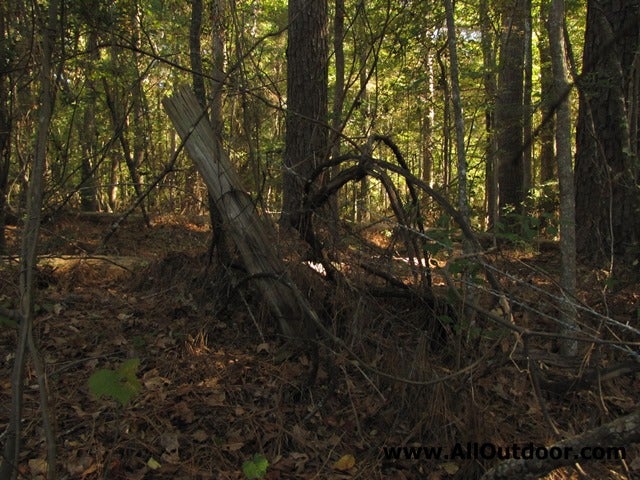Taking Down Old Livestock Fence
Kevin Felts 11.22.16

After saving money for years, the family has enough to buy a small rural farm. You walk the property and put out markers where the new livestock fence is supposed to go. The problem: you notice an old fence line that has fallen down. To make sure the farm animals are safe, you decide to remove the old fence.
First of all, is the livestock fence on a property line? If so, talk to the adjoining property owner before doing anything. Are there any right-of-ways on the property line? Do you have the legal right to take the fence down? There are numerous legal questions that have to be answered before taking the first step.
Equipment Needed
Safety gear:
- Boots: Full leather work boots with leather upper.
- Work jeans: Levis, Wrangler, etc.
- Work shirt: Long sleeve recommended, Carhart, Wrangler, etc.
- Safety glasses, if you are not wearing prescription glasses.
- Leather work gloves.
- Sidearm, small caliber rifle or shotgun for snakes.
Tools:
- Machete.
- Bolt cutters.
- Truck or trailer.
- Chainsaw, maybe.
- T-post puller, maybe.
Survey the Situation
Is this field fence, electric fence, barbed wire, barbless wire, or something else?
It is common for a combination of field fence and barbed wire to be used. The barbed wire can be one or two strands at the top and maybe a strand at the bottom.
If there are trees near the old fence line, the wire might be covered in leaves or pine straw. If the fence bottom is buried in grass, leaves, or pine straw, the bottom run of the fence may have to be left.
Types of Livestock Fence Post
Are the post wood or metal t-post? Are the wooden posts rotten, or can they be reused? If metal t-post, are they rusted out or can they be reused?
Wooden fence post that can not be reused. Either cut the post off at the base with a chainsaw or cut the fence free from the pole. Usually, fence is attached to a wooden post with metal staples or nails. Use the bolt cutters cut the nail or staple and pull the fence free from the post.
Metal t-posts require a puller to get the t-post post out of the ground. A t-post puller uses a pry bar and leverage to pull the metal bar straight up and out of the ground.
Using a Truck or Tractor
While using power equipment such as a truck or tractor, the fence posts pose a problem.
Depending on how old the livestock fence is, it may be rusted to the point where it can be pulled up with a truck or tractor. Chances are the previous land owners used galvanized fence, which makes it rust resistant.
If the fence is old, the chain may tear through the fence rather than pulling it free. Trees and vines may have grown around the fence, which will prevent it from being pulled free. Anything holding the fence in place has to be cut loose.
Bolt Cutters
If power equipment can not pull the fence free, you have to take matters into your own hands. This means using a pair of good bolt cutters. Forget wire cutters, they are a waste of time on fence. The bolt cutters I use are 18 inches long and cut through barbed wire like it was butter.
Bolt cutters get you up close and personal to the fence. If a piece of barbed wire has tension on it and you cut the wire, it can snap back.
While taking down some old barbed wire I had a piece fly back and hit me in the arm. It was just a love tap that bled nicely. My last tetanus shot was three years ago, so I was good to go.
Snakes
If leaves or pine straw have built up on the bottom strands, this is a good place for copperhead snakes.
Think of it this way: Copperheads eat large insects and mice. Wherever large insects and mice are, so will copperheads be. Pulling back layers of pine straw, leaves and grass may expose various insects. Always be in the lookout for snakes that feed on those insects. Wherever the prey is, so will be the predator.
I keep a Ruger 10/22, handgun or shotgun close at hand when dealing with an old fence row.
Transporting the Fence
Believe it or not, taking the livestock fence down is probably the safest part. Once all the fence has been removed it needs to be folded and loaded in a truck or trailer so it can be taken to a recycler.
Field fence:
- Lay field fence on the ground.
- Fold it over by hand.
- Step on the bend with your leather work boots.
- Repeat until the fence is in a nice flat bundle.
- Toss bundle into truck bed or on trailer.
Barbed wire:
- Cut wire into manageable lengths.
- Fold wire at around 12 – 18 inches long.
- Roll last section of wire around bundle.
- Toss bundle into truck bed or on trailer
Do not hold field fence at chest or stomach height and try to fold it. Field fence will have sharp points which can easily stab someone in their belly, neck, eyes or face. A stab in the belly with rusted field fence can result in a trip to the emergency room.
Safety first
Work safe.
Pay attention to what is going on around you.
Pay attention if the fence has stress on it.
Watch out for snakes.
Wear your personal safety gear.